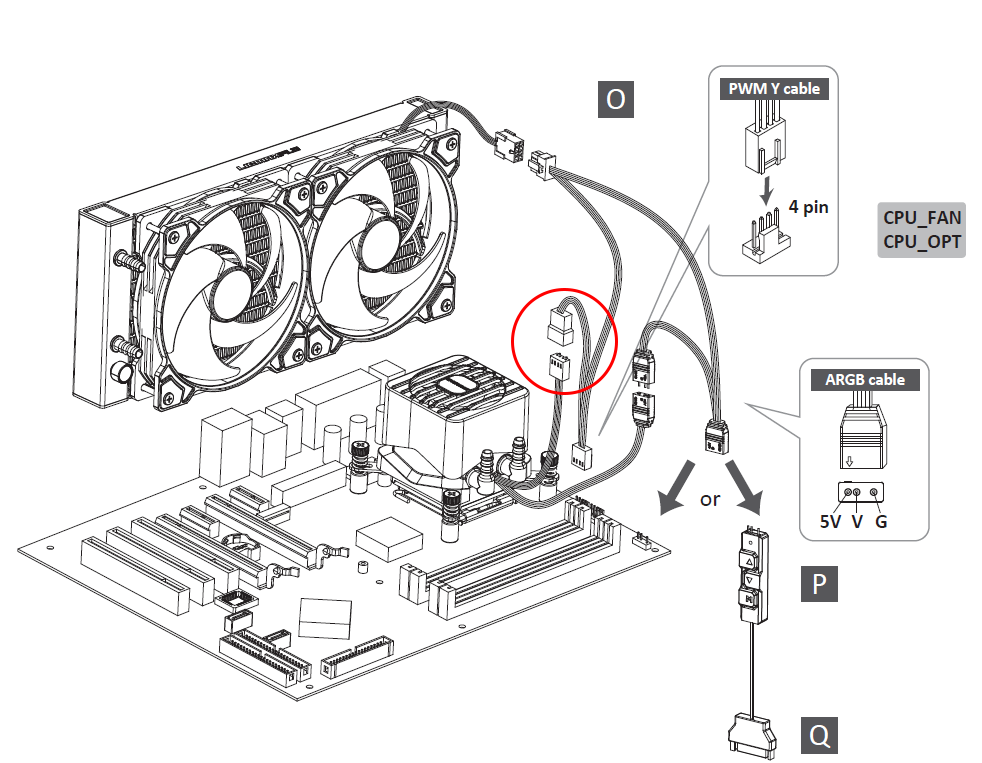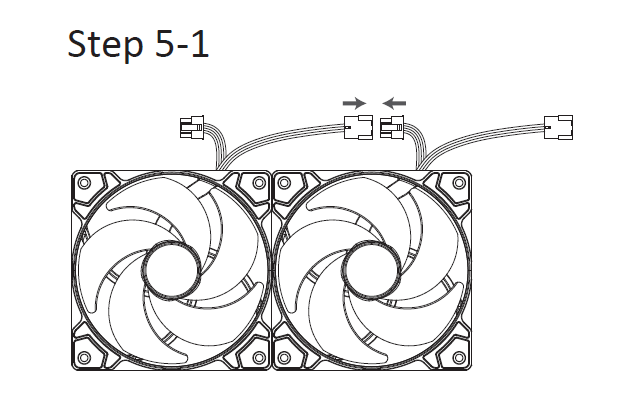COOLING
Find the answers to the most common questions you ask about the LIQMAXFLO Series:
Q1: The user manual states that "connect the fans to the motherboard with PWM Y cable" but no mention of the PWM cable coming out of the pump, what do I do with that? Also which where to on the motherboard?
A1: The red circle indicates the PWM cable of the water block. Use accessory O (PWM Y cable) to connect the fans and the water block in series, and then connect them to the motherboard. If you want the AIO cooler to retain PWM functionality, please refer to the motherboard manual and connect it to a header with PWM control.

Q2: My old AIO Water CPU cooler has two separate cables for the pump and the fan, but I only see one cable now, which fan header should I use?
A2: The fan cables of the LIQMAXFLO series have been optimized for easier cable management. With the new method, if you have more than two radiator fans, they will be interconnected first, and with just a single PWM Y Cable, both of the fans and the pump will be connected before connecting to the motherboard to create a cleaner system look. To activate the PWM functionality, please refer to the motherboard manual and connect it to a header with PWM control.

Q3: The fans are running at full speed even at idle and it's loud, is it defective? (If plugged into pump header)
A3: First, you need to check the definition of the header you have plugged into. Taking ASUS(ROG) as an example, the default mode when plugged into their "AIO_PUMP" header is full speed, which means even connecting a PWM fan to this header will run it at full speed. Since the definition varies by motherboard manufacturer, if you encounter such issues, you can enter the BIOS or motherboard software to adjust the fan mode, or you can connect the fan to another header with PWM control.
Q4: How do I control the speed of the radiator fan(s), VRM fan, or pump?
A4: Please enter the BIOS or use motherboard software to adjust the speed. If you’re using a PWM Y Cable to connect the fans with the pump, it will simultaneously control the radiator fan(s), VRM fan, and pump at the same time.
Q5: Can I set different speeds for the pump and fans?
A5: Yes, you can adjust the speed by entering the BIOS or using the motherboard software.
Q6: Is there an option to turn off the VRM fan on the ?
A6: Due to the 4-pin connector which supplies power to both the VRM fan and pump, the VRM fan cannot be turned off individually.
Q7: How do I configure my PWM settings?
A7: Please connect the cooler to a header with PWM control. For more details, please refer to the manual of the motherboard.
Q8: What speed should I set the pump speed to?
A8: It’s recommended to use the PWM function to let the fan adjust its speed based on the system load. For manual control, it’s recommended to set it at full speed to achieve the best cooling performance.
Q9: Isn't it better to have the pump set at 100% all the time?
A9: If you’d like to prioritize cooling performance over noise, you can set the pump at full speed for optimized cooling. However, if you wish to have a low noise during low loads, you can use the PWM function to control the pump to achieve the balance between noise and performance.
Q10: My system is reporting the RPM at 0, is the pump dead?
A10: If you encounter this issue, please access the BIOS or your motherboard software to check if the fan mode is set to 0 rpm control.
Q11: My system is reporting the RPM at 1207, does that mean it's the speed for both fans, pump, and VRM fan?
A11: The PWM Y Cable which is included with the LIQMAXFLO SR series will detect the speed of the radiator fan, so the 1207 RPM is the speed of the radiator fan. If you want to detect the speed of the VRM fan, you can connect the 4-pin header of the water block separately to the motherboard to get the speed of the VRM fan.
Q12: My fan is barely turning, are the fans dead?
A12: If the fan speed is set to its minimum start-up threshold, it might prevent the fan from operating correctly. Please avoid setting it to the minimum start-up threshold.
Q13: My motherboard is giving me a warning that no CPU_FAN is detected at bootup, what should I do?
A13: Each motherboard manufacturer sets one of the headers to be essential for a successful boot, usually labeled as CPU_FAN. This header isn't specifically for either the PUMP or the fans; as long as it is attached. In the LIQMAXFLO AIO cooler, fans and water blocks are connected through the PWM Y Cable which can be connected to CPU_FAN as a necessary condition for booting. Also, each motherboard manufacturer may have different naming conventions. Please refer to the motherboard manual for more details.
Q14: The header on my motherboard is not supplying enough power, what should I do?
A14: Generally, the current supplied by a header is between 2 - 3A. For the LIQMAXFLO 420mm AIO, the total current is approximately 0.67A (Fan-0.08A*3 + Pump-0.43A), so there shouldn't be an issue of insufficient power from the motherboard. If you happen to have a motherboard with a lower power supply, you can remove the water block's 4-pin connector from the PWM Y Cable and connect it separately to another header to distribute the current.
Q15: What does the included SATA adapter do?
A15: The SATA adapter is an extra accessory that allows you to connect the power supply with any of the 4-pin devices.
Still can't find the answers you want? Click the picture below to connect with one of ENERMAX's experts!
● Efficient cooling with maximum performance
● Cooling with possible thermal throttling under heavy load
● Thermal throttling under load
* Be aware that the recommended cooler can only work as intended if the case is providing adequate airflow, and the cooler performance is tested when the CPU is running full loading.
* The TDP of coolers are calculated by Thermal resistance testing machine, please refer to the formula "TDP (Watts) = (tCase (° C) - tAmbient (° C)) / (HSF Θca)"
| Thermal resistance= (Tc- Ta)/ CPU Input Power = n ℃/W. Whereas Tc= CPU Core temperature. Ta= Ambient temperature. The thermal resistance of 0.1℃/W cooler means when CPU increases 1W power consumption, the cooler will have the CPU temperature increase 0.1℃. Therefore, smaller the thermal resistance value, higher cooling performance of the cooler. |
| The ideal material for air cooler shall have good thermal conduction and absorption factors. Silver, copper are great thermal conductive material, following by gold and aluminum. For cost control, the cooling industry prefer copper and aluminum. Copper has good thermal conductivity, yet its absorption capacity is smaller than aluminum. Therefore copper is ideal material for heat pipe or cooling base plate. Aluminum is lightweight, easy to cast, and is ideal for fins, radiator. |
| Some of ENERMAX products support RGB lighting synchronization and some support addressable synchronization. The difference is that RGB lighting synchronization requires 12V support through motherboards and the RGB sync header on motherboards is 4 pin (pin assignment: 12VGRB). On the other hand, the addressable RGB synchronization requires 5V support through motherboards and the addressable sync header (a.k.a. ARGB header) is 3pin (pin assignent: 5V/D/G) |
| ENERMAX joins Razer Chroma eco system and most of ENERMAX products are compatible with Razer Chroma. In order to use Razer software, Synapse, to control the lighting effects of your system, make sure your motherboard can support Razer Chroma, more information, please visit Razer website: https://www.razer.com/chroma |
| Liquid cooler has higher thermal absorption capacity and faster conductivity than air cooler. Therefore it is a good weapon to elimiate the CPU hot spots when over clocking. For heavy-duty system, or CPU with auto-over-clocking function, it is recommended to use liquid cooler. |
| The micro-channel structure is adding the numerous fins on the cold plate to form very narrow gap channels for coolant to pass through. This design will greatly increase the the contact area to boost the thermal exchange rate. |
| The coolant usually contains the anti-freezing and anti-corrosion additives. The additives must be carefully diluted, otherwise the cooling performance will be reduced. |
| When the fluids pass through a surface, partial of the fluid will form a residiual film on the surface, known as boundary layers. This layer will obstruct the heat exchange efficiency. For liquid cooler, reducing the boundary layer in micro-channel (base plate) will help to boost the cooling performance. Enermax patented Shunt Channel Technology plays an importat role to eliminate the the boundary layer and reduces flow resistance. |

